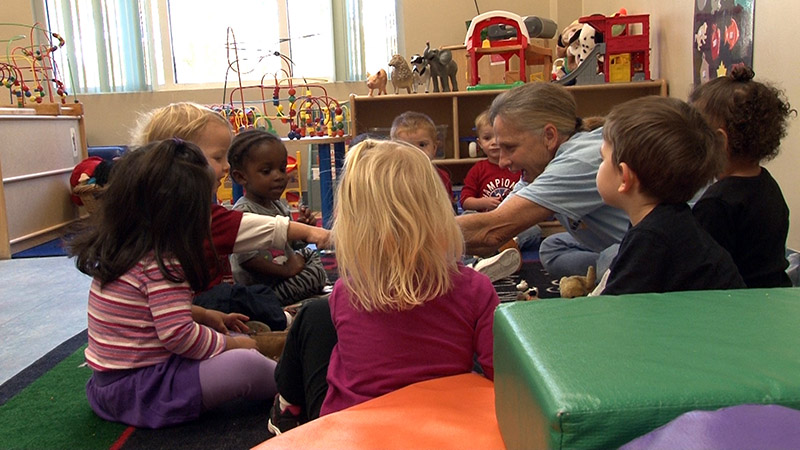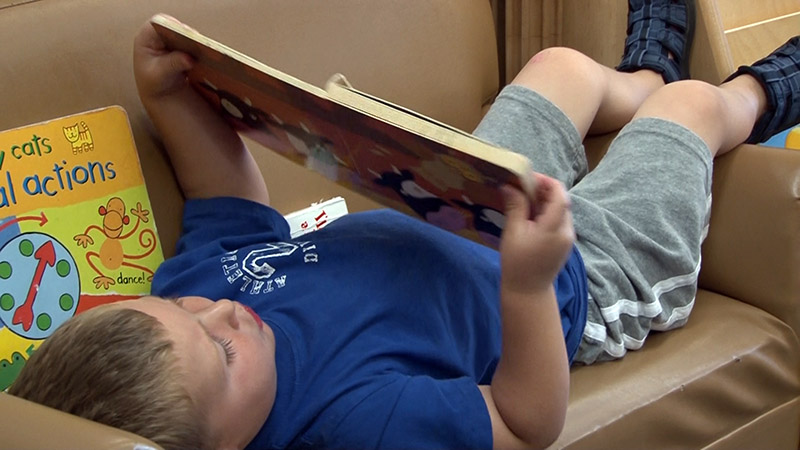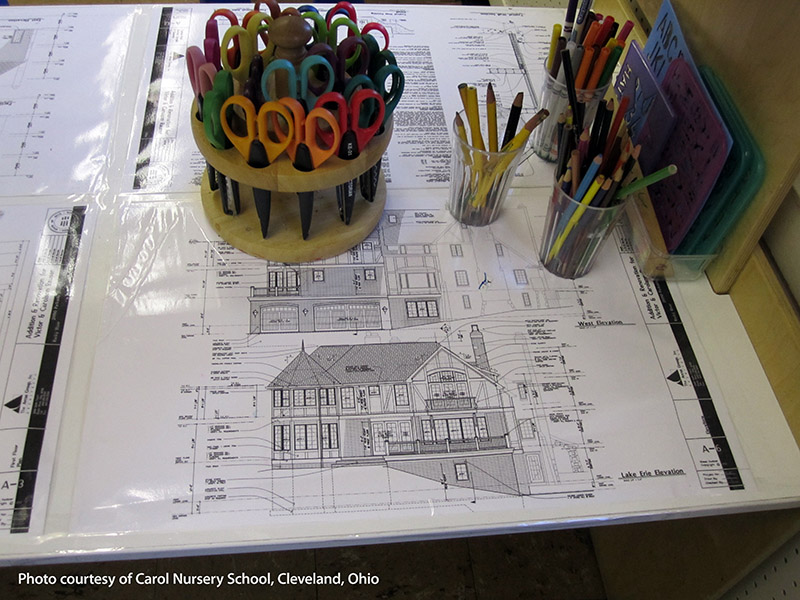就像成年人一样,当他们不容易通过环境时,孩子们会受到沮丧,或者找到他们需要的东西。正是我们的工作是教师,以确保教室是思想的设计,并且戏剧材料很好地组织。本课程突出了如何为集团活动,隐私,存储和显示器设计您的房间,并注意所有学习者。它介绍了促进舒适感和邀请探索和参与的设计元素。本课程还审查了如何组织独立材料,轻松使用和学习。狗万app怎么下载
辅助标签
- 区分集团活动的空间,隐私,存储和显示。
- Learn ways to make environments feel “home-like” and create provocations.
- 介绍如何组织独立材料,轻松使用和学习。狗万app怎么下载
- Design engaging and well-organized indoor environments for preschoolers.
Learn
Know
如引言课程中所讨论的,环境发送强大的消息。精心规划的环境可以帮助学龄前儿童感到平静和安全,同时,从事和好奇。万博体育全站app在第一课中,我们介绍了在学龄前儿童设计环境中考虑的一般想法,以及促进学习的主要课堂兴趣区。万博体育全站app狗万app怎么下载但是,在设计或重新设计课堂空间时,考虑物流,美学,组织以及空间中所有儿童的需求也很重要。
物流设计
In your preschool classroom, you will need spaces for group activities, privacy, and storage and display.
集团活动的地方

Although children learn primarily through play, it is also important to plan areas for large-group meetings or activities. Morning meetings and story times build classroom community and literacy skills. Having designated spaces for these activities and designing them to minimize distractions can help you make the most of these times. This doesn’t mean you need a spot just for group activities. In some smaller classrooms, this simply is not possible. Teachers in such classrooms can get creative! The block area can be a perfect space for large-group activities. Simply covering the shelves with sheets, or flipping around shelves on wheels, or adding a stop sign can help minimize distractions and support children’s successful engagement with the group. In other classrooms, the library or music and movement area is a natural home for large group activities. Just ensure there is enough space for everybody to sit comfortably.
无论你见面的地方,从孩子的角度来看都很重要。当我们知道如何成功时,我们都感觉更好。对于学龄前儿万博体育全站app童来说,这可能意味着了解在哪里以及如何坐在哪里,在哪里关注关注和该做什么。Nametags,座垫和垫子或其他简单的标记可以帮助定义小组内的儿童的个性空间。
Places for Privacy

Preschool classrooms are high-energy places. Similar to adults, children sometimes need time and space to relax on their own. You can help children meet this need by offering spaces that are limited to one or two children. The library, a cozy corner, quiet games or other spaces of your room can help children calm themselves. Consider how the use of sheer fabrics or the placement of furniture can help create these cozy nooks and still provide good visibility.
Places for Storage and Display
Preschool classrooms require many materials! Toys, books, games, and other resources are regularly rotated in and out of active use. It is important to plan for at least three kinds of storage in a preschool classroom: open storage for children to access, closed storage for teacher materials and storage for personal belongings (Dodge et al., 2010). It is also important to plan for storage and display of children’s assessment materials and artwork.
- Open Storage:对于积极使用的材料,教师应该将它们存放在开放式上标有架子上。如下所述,开放存储促进可访问性。
- Closed Storage:Tools such as office supplies, cooking utensils or cleaning fluids should be stored securely when not in use. Again, it is important to designate and carefully label secure locations for these items. This will help you maintain inventory and ensure children’s safety.
- 个人存储:儿童和成年人需要空间来存储他们的个人物品。儿童的个人存储应该用图片和单词标记。这有助于发送每个孩子所属的消息。它还可以帮助缓解下降和拾取的惯例。儿童的个人存储空间还允许他们在需要时轻松访问他们的个人物品(例如,在需要户外进行户外活动)的个人物品,支持他们的自主权。对于成人的个人存储,储存商品的个人储存是重要的,因为钱包或背包等物品可能包含儿童的材料(例如,化妆或药物)。
- 展示:存储和显示艺术品和投资组合向儿童发送有关其工作价值的强大消息,并帮助您更有效地完成工作。它与儿童沟通这是一个测试他们想法的地方,帮助您更轻松地跟踪儿童的发展进展。
观看此视频以查看课堂设计的示例,专为组活动,隐私和存储而设计。
设计学习空间狗万app怎么下载
美学
在介绍课程中,我们解决了高质量的学龄前计划向儿童发送众多积极信息。万博体育全站app您可以与儿童沟通的最佳方式之一,您的教室是“一个好地方”是通过小触摸你在整个房间里表达课堂的人格。
家里的
孩子们更有可能觉得自己可以自己,并且当他们的课堂环境就像他们的家园时,有归属感。有很多方法可以为您的教室添加个人触摸以创建家庭的感觉(我们将在材料课上讨论此内容)。例如,您可以包含:
- 软家具,如沙发或大型扶手椅
- 无毒植物
- 通过使用窗户或灯具或灯具自然或柔和的照明
- Throw pillows, cushions
- Other decorative touches, such as area rugs or repurposed furniture
- 儿童和员工的家庭照片
- 廉价的框架挂在墙上的儿童艺术品
- 中性漆色
记住孩子们可能在教室每天花几个小时。创造放松,家庭类似的环境至关重要。在视觉压倒性的空间中花费八个或十二小时,它可能会压倒八个或十二个小时,明亮的灯光或鲜艳的色彩。家庭环境的环境,除了隐私和安静的地区的地方,提供儿童有机会在需要时寻求平静。
 Including pictures of the children and their families, in conjunction with personal storage and displaying children’s artwork, is another great way to communicate that this spaces belongs to the children. When displaying pictures or adding decorative touches, remember to hang or offer many items at children’s eye level to reinforce that they are valued members of the classroom space.
Including pictures of the children and their families, in conjunction with personal storage and displaying children’s artwork, is another great way to communicate that this spaces belongs to the children. When displaying pictures or adding decorative touches, remember to hang or offer many items at children’s eye level to reinforce that they are valued members of the classroom space.
Inviting Engagement: Provocations
You can also offer items of beauty or wonder in the classroom that invite children’s exploration and engagement using provocations. A provocation is a picture, experience or item that provokes thought, interest, questions or creativity (Edwards, 2002). In the Materials lesson ahead, we will address different considerations when selecting materials for your classroom. Provocations can help “provoke” children to use, think about or see materials in new ways. When designing your classroom, it can be useful to think about how you will incorporate provocations. Your inspiration for what provocations to offer will often come from children’s current interests and their learning goals. Provocations could be:
- 图片:包括儿童兴趣的图片可以帮助探索某些概念,并发送儿童思想在教室中估价的信息。尽可能多地使用真实物品的图片。
- An Event or Experience:例如,去实地考察,自然在户外步行或在教室里举办“茶派”。您也可以在活动期间拍摄照片以稍后显示。与个人存储和儿童艺术品一起使用这些图片,也会传达这个空间属于孩子。
- 书:与儿童目前的兴趣相关的战略性地放置书籍可以改变他们的戏剧和参与。例如,在再生材料箱旁边的机器人提供一本书。
- Items from Nature:This includes items you have collected from outside, such as leaves or nuts, or a vase of fresh flowers.
- 显示简单更改:例如,在块区域中添加一个儿童安全镜子,铺设了一个上面的一些玩具船,可以帮助孩子们更多地了解水运,并刺激它们以创造不同的船只和驳船。

Consider the placement of your provocations. What are you hoping children will do within each interest area? What concepts are you currently exploring and how might a provocation in certain areas help extend or focus children’s play? Provocations are meant to be a guide or a point of inspiration for how children can engage with certain materials or spaces, but remember they are not meant to be an ultimatum for what children are supposed to do in each area or with the materials. For example, perhaps you set up a restaurant scene with corresponding props in the dramatic play space, but today, the children are using it as their home kitchen. That is alright; not every provocation will interest every child. If children consistently ignore certain provocations that can be a sign they are no longer interested in that particular concept or idea.
Designing for All
When you look to design or redesign your classroom, you need to consider the needs and learning goals for all children. Each time a new preschooler enters your room, you should consider what changes need to be made to best support their engagement in the classroom. For children with special needs, it is important to speak with the child’s family and your trainer, coach or supervisor so you know the child’s particular needs and what supports will help them. As we will discuss in the Materials lesson, assuring that your classroom is welcoming to children from diverse cultural backgrounds is also critical to supporting the success of all children in your room.
In terms of environmental design, you may need to consider the physical space within interest areas or pathways between interest areas to assure children with physical disabilities can easily move around and participate. In addition, all children, but particularly children with social or behavioral needs or certain developmental disabilities, may benefit from a designated “cool down” area, where they can easily access materials that help them soothe themselves and where they can spend some minutes alone. In the “cool down” space, you could also offer pictures of children expressing different emotions to help children identify what they feel, and pictures with words about different calming strategies (e.g., “take deep breaths”). For children with autism or communication difficulties, it can also be helpful to provide multiple visual cues for how to use the spaces and materials. This could include providing a picture of children safely playing in the space within the “entrance” to each interest area, or offering a small series of pictures showing how a child could pinch or roll the clay with their hands or use the available clay tools next to the clay in the art area. See Kids Included Together (KIT) for more ideas on how to support children with special needs in your setting (https://www.kit.org/who-we-are/our-work/)。
有关创建环境以支持所有子项的更多信息,请查看此视频。您还可以看到有特殊需求的儿童的环境支持,自适应设备和材料的例子学习附件。
为所有学习者培养空间
组织
想象一下走进你熟悉的街区杂货店,快速抓住晚餐的成分,只发现过道和物品已重新排列或不再可用。现在应该快速旅行变成了30分钟的清道夫狩猎。你可能会感到沮丧和沮丧。当他们找不到所需的东西时,孩子们也可以感到沮丧,并且当戏剧的材料无法使用时。
As teachers, it is your responsibility to make sure materials are easily accessible and well organized. When organizing your materials, you should think about three goals: independence, easy use and learning.
组织独立性
 首先,我们希望孩子们知道他们可以自己找到和使用材料。完成这一点的最佳方法是将材料存储在低,开放的架子上。这允许儿童看到可用的材料,做出选择并退回没有成人支持的物品。使用低,开放的架子以简单而有吸引力的方式显示玩具和材料。但请记住,太多的选择可能会压倒。
首先,我们希望孩子们知道他们可以自己找到和使用材料。完成这一点的最佳方法是将材料存储在低,开放的架子上。这允许儿童看到可用的材料,做出选择并退回没有成人支持的物品。使用低,开放的架子以简单而有吸引力的方式显示玩具和材料。但请记住,太多的选择可能会压倒。
Second, we want children to learn to use signs and symbols in the environment to support their independence. The major way we help them do this is by carefully labeling objects or the places where objects belong. The best labels use written words plus pictures or parts of the object (like a puzzle piece on a puzzle box). Labeling not only helps children learn to clean up independently, it also creates a print-rich environment. As an added benefit, you may find yourself giving fewer directions and reminders. When children can engage independently with materials, you have more time for interacting and expanding learning opportunities.
组织方便
应组织材料所以孩子们想要与他们互动。组织您的材料非常重要,所以孩子们可以在需要时找到他们所需要的东西。这也有助于孩子们知道“我可以自己做事”。有组织的材料使儿童能够尝试想法并使用新材料。组织方便使用时,请考虑将像材料一起存储在一起。像材料一样,是某些活动所必需的东西的东西。像孩子一样思考:如果我想在写作中心工作,我将需要什么或想要什么?放置铅笔,蜡笔,标记,纸质,剪刀,贴纸,模板,邮票,信件卡,字卡,名称卡片和图片词典都在写作区域可以允许孩子们立即参与他们的想法。这意味着您可以在房间的许多地区有重复的材料。铅笔,纸张和剪贴板在施工和戏剧性游戏区域也很有用,因此应在那里存储一套,以便于使用。
 The types of storage you choose, including bins, baskets and containers, can affect how easily children access and put away materials. For example, storing books on a shelving unit that allows children to see the full front covers may spark greater interest in reading and make it easier for children to choose a book they find interesting. Storing simple wooden puzzles on a puzzle rack will also make it easier for children to choose a puzzle and return it to its place when finished playing. Storage bins should be open (without lids) for materials that you want children to access themselves. Bins should also be made of lightweight material (e.g., plastic vs. metal) and not too large or too heavy that children cannot handle them on their own. Clear plastic bins will allow children to easily see the materials that are inside. Bins should also be large enough to accommodate materials without tipping over. Baskets should not be made of materials that could poke or scratch children, and should not be used to store materials that can fall out through the holes (e.g., crayons). Wheeled carts that can transport books or bins of materials may make it easier to rotate materials.
The types of storage you choose, including bins, baskets and containers, can affect how easily children access and put away materials. For example, storing books on a shelving unit that allows children to see the full front covers may spark greater interest in reading and make it easier for children to choose a book they find interesting. Storing simple wooden puzzles on a puzzle rack will also make it easier for children to choose a puzzle and return it to its place when finished playing. Storage bins should be open (without lids) for materials that you want children to access themselves. Bins should also be made of lightweight material (e.g., plastic vs. metal) and not too large or too heavy that children cannot handle them on their own. Clear plastic bins will allow children to easily see the materials that are inside. Bins should also be large enough to accommodate materials without tipping over. Baskets should not be made of materials that could poke or scratch children, and should not be used to store materials that can fall out through the holes (e.g., crayons). Wheeled carts that can transport books or bins of materials may make it easier to rotate materials.
The steps you take to organize for independence and easy use will also help you keep the space tidy, prevent tripping hazards and ensure clear pathways to exits in emergencies. Children will know where materials belong and they won’t have to carry materials far from their storage spaces. Furthermore, these strategies help children respect the materials and the classroom environment.
组织学习狗万app怎么下载
如上所述与挑衅概念,您可以组织您的空间,以激发或建立在儿童的利益上。可以安排显示(例如,图片,海报或墙壁挂钩),帮助儿童探索想法或尝试附近的适当材料。展示应该是儿童的眼睛水平,应该包含自己的工作,与他们的兴趣相关的图片,或者图片意味着帮助引发进一步的探索。他们应该反映社区中教室或家庭中不同儿童的背景,知识和经验。为了维持儿童参与的游戏和学习,您将定期旋转材料,因此儿童有机会使用不同类型的材料。狗万app怎么下载
You can organize your space so children encounter meaningful learning opportunities throughout the day. This means providing well-organized and well-planned literacy, math, science and social studies materials in interest areas. For example, offer a basket of menus, pads for taking orders, shopping lists and cookbooks in the dramatic play area. Keep tape measures, clipboards, blueprints and books about famous structures in the block area. The art area can include books, paintings or other materials from a wide array of cultures.
See
为独立,轻松使用和学习组织您的空间和材料非常重要。狗万app怎么下载观看以下视频,看看学龄前教师组织他们的材料,以满足这三个目标。万博体育全站app
组织材料
Do
Classroom arrangement is an art and a science. It is an art for you to make your classroom feel welcoming and like a home. It is a science as you use knowledge of developmentally appropriate practice to plan your classroom’s floor plan.
- Make the Classroom Feel Like Home:Use suggestions in this lesson to make your classroom feel comfortable yet engaging.
- 给孩子他们需要什么:认识到孩子们在你的节目中花了很多时间,每个人有时需要休息。提供各种方式,儿童可以为自己花费一点时间;一个安静的书籍区域,电脑中心或艺术区都可以从繁忙,社交日开始短暂休息。这对具有特殊需求的儿童来说尤为重要。
- 未雨绸缪:Consider how you will use spaces for group activities, storage and display. Then identify the resources you need to make those spaces work. For example, ensure you have storage for items you use every day in your group spaces. A rolling cart that holds the day’s books, CDs or finger puppets can be very useful. Think about how you collect and use child assessment information. You might be more likely to keep your records current if they are in a visible location. List all the materials you will need in each space based on the activities, storage and displays that you are planning.
- 保持安全优先:When designing your space, ensure you can supervise all areas, including private spaces. Make sure that you have secure storage for all items that are unsafe for children. A well-designed classroom will also keep children engaged in appropriate play and help prevent undesirable, unsafe behaviors (e.g., jumping, running). See the Safety course for more information.
Remember your classroom sends messages to children. We want the classroom to help children say, “I can do things on my own here” and “this is a place I can trust.” There are simple ways your classroom sends these messages. By organizing for independence, easy use and learning, you can make your classroom a more effective space and prepare children for learning.
- 确保货架和课堂材料克丽rly labeled and materials are stored where they are easy to use. You can use drawings or photographs to make labels.
- 靠近桌子或地毯的商店棋盘游戏或难题。
- 将游戏面团和器具一起存放在一起。如果孩子使用托盘或带面团的餐垫,请将那些面团和器具的盒子储存。
- 将艺术材料(珠子,棉花球,羽毛,丝带)放在艺术表附近的透明容器中。保持胶水,剪刀和纸上方便。
- 将您的所有户外玩具储存在门附近的大包或篮子里(如果您没有这些物品的外部存储)。
- 考虑儿童将如何访问艺术,水和其他凌乱的戏剧。战略上储存手柄,所以孩子们可以在必要时得到它们。
- 托盘可以是老师最好的朋友。它们帮助组织材料并定义每个孩子的空间。如果孩子只需要一套活动或游戏,请考虑使用必要的材料制备一组托盘,并将其存放在儿童的桌子或货架上。
- Think about the materials you currently need to support the children’s interest, current skill level and learning goals. Remove and/or rotate materials to avoid overcluttering and to support focused engagement.
探索
看到其他教师如何组织他们的空间有助于。下载并打印如何更好地组织或准备activity. Watch the videos and answer the accompanying questions. Then share your responses with a trainer, coach or supervisor. Finally, compare your answers to the suggested responses.
Organizing The Space For Engagement
Apply
下载并打印使用工具document and keep it as a resource. It provides a list of room arrangement tools that can help you design your classroom—without any heavy lifting!
Label the materials in your classroom if you have not done so already. You can download and print the标签below to help you get started, or use a camera to take pictures of your own materials and use those as labels. You can also invite children to assist with this process, by asking them to draw the items or to help write the words. Whatever you use, cut the labels out and use them to identify the places you store each item.
Glossary
| Term | 描述 |
|---|---|
| 美学 | Attractive or pleasing in appearance. In this lesson, we discussed aesthetics in terms of creating a home-like, yet engaging classroom environment |
| Developmentally appropriate environment | 适合发展中儿童的发展阶段,但仍然足够灵活,以便在技能,兴趣和特征之间进行孩子之间的差异 |
| Interest areas | Defined classroom spaces used for certain purposes or types of play. Examples are toys and games, blocks, dramatic play, discovery, art and science |
| 低,开放式架子 | Designed so adults can see over or through them at all times and children can access the materials they need |
| Provocation | 激发思想,兴趣,问题或创造力的图片,经验,展示或项目。挑衅为儿童提供了他们可以与材料互动的方式的灵感或指导 |
Demonstrate
Bredekamp,S.&C. Copple,EDS。(1997)。在幼儿期方案中的发展适当的做法(修订编辑。)。(第152-153页)。华盛顿特区:国家幼儿教育协会。
Dodge,D.T.T,Heroman,C.,Berke,K.,Bickart,T.,Colker,L.,Jones,C.,Copley,J.,&Dighe,J.(2010)。The Creative Curriculum for Preschool(第五次)。Bethesda,MD:教学策略,Inc。
Dodge, D. T., & Kittredge, B. (2009).Room Arrangement as a Teaching Strategy DVD。华盛顿特区:教学策略,Inc。
Edwards,C. P.(2002)。来自欧洲的三种方法:Waldorf,Montessori和Reggio Emilia。Early Childhood Research and Practice,4(1)。从...获得https://digitalcommons.unl.edu/cgi/viewcontent.cgi?article=1001&context=famconfacpub
Farran,D.C.C.,Aydogan,C.,Kang,S. J.,&Lipsey,M。(2006)。万博体育全站app学龄前教室环境和儿童识字和语言行为的数量和质量(第257-268页)。在D. K. Dickinson和Neuman,S. B.(EDS。),Handbook of Early Literacy(第1卷)。纽约:桂福德出版社。
弗罗斯特,J.L,Shin,D.,&Jacobs,J.L.(1998)。物理环境和儿童的戏剧。在O. N. Saracho&B. Spodgk(EDS),幼儿教育中发挥的多个观点。纽约州奥尔巴尼:纽约州立大学出版社。
格林曼,J。(2007)。关怀空间,学习场所:儿童的环境狗万app怎么下载。Redmond, WA: Exchange Press, Inc.
Grisham-Brown,J。,Hemmeter,M.L.,&Pretti-Frontczak,K。(2005)。在包容性环境中教授幼儿的混合实践。巴尔的摩:布鲁克斯出版有限公司
McWilliam, R. A., & Casey, A. M. (2007).Engagement of Every Child in the Preschool Classroom。巴尔的摩:布鲁克斯出版有限公司







